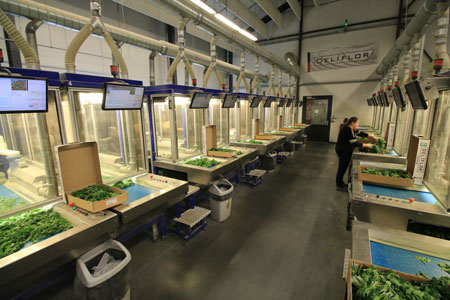2/26/2016
A Roomful of Robots
Chris Beytes
Photography by Chris Beytes
 GrowerTalks’
GrowerTalks’ editors never like to go to a trade show without getting into a greenhouse, so the day before IPM Essen (Germany) started, your scribe made a detour to Maasdijk, in the heart of the Westland in the Netherlands, to visit young plant breeder and producer Beekenkamp, which has more plant transplanting robots than any other company in the world.
Actually, it’s Beekenkamp’s sister company, Deliflor, which has a roomful of robots that’d I’d heard about but never seen. Designed and built by Iso Group, they work away assiduously for two shifts per day planting about two million chrysanthemum cuttings per day. That adds up to more than half a billion cut mums per year, planted into traditional soil cubes and shipped to cut flower nurseries across Europe.
Pictured: The transplanter room at Deliflor in Maasdijk, the Netherlands. Robots do the tedious task of transplanting 3,000 cuttings per hour each (about the speed of a skilled human), while a couple of workers keep the robots supplied with cuttings and watch for problems. Workers also double check all the trays coming out of the room.
After decking me out in a “bunny suit,” booties and gloves and showing me around their hospital-clean production greenhouse, we headed to the transplant room, where two rows of robots—24 in total—click and zip and pound away rhythmically. Another six handle smaller cuttings. Thirteen more robots work away at their Breuchem
location.
Now, “pound” is not a sound you’d associate with a robot; that’s the sound of each machine’s feed belt vibrating frantically several times to toss the cuttings that lay upon it. That allows the overhead cameras and associated computers to search for and identify the cut end of the mum cuttings. The computer tells the transplant head where to locate and pick up four cuttings, which it then sticks into grippers that do the final transplant rooting cubes.
It’s a fast and slick process that appears to continue without fail. It would take 42 workers to transplant as many cuttings, and they wouldn’t be as dependable or consistent. It takes just six workers to oversee the process. (They do still transplant small lots by hand.)
I shot some video, but it won’t be any better than this one that’s already on YouTube: http://tinyurl.com/transplantrobot.
The precision of the robots could be because the whole idea has been in the works for decades. I learned that from An Beekenkamp, the second-generation co-owner (with her sister, who’s not active in the business).
Said An, “We’ve looked for these machines for 25 years, but it hasn’t been possible because every cutting is different.” Now, thanks to cameras and computers, it is possible.
There are numerous reasons Dutch growers have been chasing automated transplanting, including ever-increasing labor costs, labor shortages and being able to get the job done in the timeframe required. Robots are also more consistent than humans, which increases quality.
“The robots are so good,” An says. “They put the plants into the pots the same way every time.”
The next frontier? Transplanting other types of cuttings, such as petunias and begonias. They’re already working on that dream.
GT